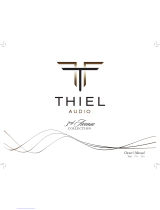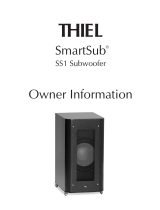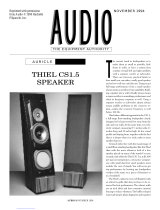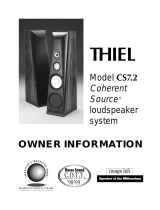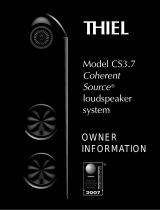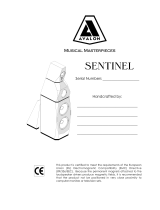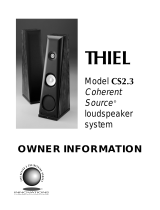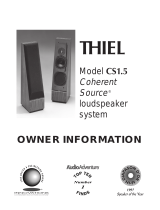Page is loading ...

Technical Information
THIE L
Coherent Source
®
Loudspeakers
This paper describes some of the technical performance aspects, design
considerations and features of THIEL Coherent Source® loudspeaker systems. It is
intended to supply information for those who are interested in such matters. It is not
intended to imply that good measured technical performance is sufficient to
guarantee good sonic performance.
THIEL • 1026 Nandino Boulevard • Lexington, Kentucky 40511 • USA • Telephone: 859-254-9427
Fax: 859-254-9427 • E-mail: [email protected] • Web: www.thielaudio.com
7/00

THIEL DESIGN PHILOSOPHY
All THIEL speakers are intended to be precision instruments that very accurately translate electronic information into musical sound. All our
efforts have been directed toward achieving extremely faithful translation of all tonal, spatial, transient and dynamic information supplied by
the amplifier. THIEL speakers are not intended to mask or mitigate shortcomings of the recording or other components in the music
playback system. We believe this approach is the only way to provide the potential of experiencing all the subtle aspects that help make
reproduced music a most enjoyable human experience.
Performance goals
Since quality of musical performance is a very complex issue it is helpful to objectively identify the aspects involved. We believe musical
performance can be described, with not much oversimplification, as performance in four areas.
Tonal fidelity includes overall octave-to-octave balance, the fidelity of timbres, absence of vowel-like colorations, and bass extension.
Spatial fidelity includes how wide and deep the performing space seems, how convincingly instruments are placed from the center to
beyond the speakers laterally, how realistic the depth perspective is, how little the speakers’ positions seem to be the source of the sound,
and how large the listening area is.
Transient fidelity includes how clearly and cleanly musically subtle low–level information is reproduced and how convincingly
realistic is the reproduction of the initial or ‘attack’ portions of sounds.
Dynamic fidelity includes how well the speaker maintains the contrasts between loud and soft and how unstrained and effortless is the
reproduction of loud passages.
Fundamental design considerations
In our opinion, natural spatial reproduction requires creating a realistic sound field within the listening room by mimicking the properties of
natural sound sources. These properties include wide area radiation and the absence of out-of-phase energy. To meet these requirements all
THIEL speakers employs dynamic drivers. Dynamic drivers have the advantages of providing a point source radiation pattern with good
dispersion of sound over a wide area, great dynamic capability, good bass capability, and a lack of rearward out-of-phase energy. Another
advantage of dynamic drivers is that their small size allows the multiple drivers to be arranged in one vertical line. This alignment avoids the
problem of side-by-side driver placement which causes the distances from each driver to the listener to change with different listener
positions.
The major potential disadvantages of dynamic speakers are diaphragm resonances (“cone breakup”), cabinet resonances and cabinet
diffraction. Also, they share with other types of speakers the potential problems of time and phase errors introduced by multiple drivers and
their crossovers. None of these problems is a fundamental limit and all can be minimized or eliminated by thorough and innovative
engineering, allowing the possibility of a speaker system without significant fundamental limitations.
Technical requirements
The task of engineering a speaker system requires the translation of the musical performance goals into technical goals. Although there are
also many minor design considerations, the following are what we believe to be the major technical requirements that contribute to each of
the musical goals.
Tonal fidelity:
• Accurate frequency response so as to not over or under emphasize any portion of the sound spectrum
• Absence of resonances in the drivers or cabinet so as not to introduce tonal colorations
Spatial fidelity:
• Point-source, unipolar radiation
• Time response accuracy to preserve natural spatial cues
• Lack of cabinet diffraction
• Even dispersion of energy of all frequencies over a wide area
Transient fidelity:
• Phase coherence to provide realistic reproduction of attack transients
• Very low energy storage to provide clarity of musical detail
Dynamic fidelity:
• High output capability
• Low distortion
Design goals
The technical requirements result in the following major technical design goals:
1. Very uniform frequency response
2. Time response accuracy
3. Phase response accuracy
4. Low energy storage
5. Low distortion
1

2
THIEL ENGINEERING
All THIEL speakers share several very unusual (and costly) engineering features that are fundamental to our engineering approach and
enable them to achieve very high performance. The most noteworthy of these are:
• Complete phase coherence (the elimination of phase distortion) achieved by the use of first-order crossovers.
• Accurate time coherence (absence of inter-driver time delays) achieved by coincident/coaxial driver placement and/or sloping baffles.
• Short coil/ long magnetic gap motor systems that drastically reduce distortion.
• Very rigid, heavy cabinet construction.
• Reduced cabinet edge diffraction achieved with rounded baffle edges.
• Aluminum driver diaphragms whose stiffness eliminates resonances in the operating range.
The following material briefly explains the engineering techniques used to achieve our design goals. Under frequency response is
discussed driver diaphragms, diffraction, network correction and off-axis response. The section on time response covers correction by
driver alignment. Phase response explains phase correct first order crossover systems. Energy storage covers cabinet construction and
distortion covers various aspects of motor system design.
Some generic examples and measurements are given and the reader is referred to model-specific information and measurements that
are contained in the model-specific technical information pamphlet.
FREQUENCY RESPONSE
Since frequency response errors are a measure of tonal imbalances which alter music's tonal characteristics, we believe that accurate
frequency response is an absolute requirement for a truly good speaker. Even though incorrectly balanced speakers may sound pleasant,
and even be preferred by some people, our goal is to produce very accurately balanced speakers. In our opinion the human ear is sensitive
enough to the balance between component harmonics of musical sounds to detect frequency balance errors of as little as 0.2 dB if they are
over a range of an octave or more. Therefore, even more important than the maximum amount of response error at any frequency is the
octave averaged, octave-to-octave balance which has a very high correlation with perceived tonal balance. Our design goal is to achieve
octave-averaged response within ±0.5 dB from 50 Hz to 10 kHz. Any deviation more than .5 dB is confined to only a narrow frequency
range and therefore will have less effect on the perceived balance.
Achieving this goal requires the use of drivers with very uniform responses, reduction of usual cabinet diffraction which causes
response errors, and compensation of driver response anomalies in the electrical network.
Driver response
The major cause of nonuniform driver response is diaphragm resonances. These resonances are also the major energy storage mechanism.
In THIEL products all driver diaphragms ( with the exception of the CS.5 woofer and the CS3.6 midrange) are constructed of anodized
aluminum which provides much higher stiffness and compressive strength than conventional diaphragm materials. The primary benefit is
that the lowest internal resonance is much higher than with other materials. Below this lowest resonance there are no resonances to store
energy and cause ringing. An additional benefit is that aluminum’s higher compressive strength results in more of the energy of a transient
attack being transferred to sonic output rather than being absorbed in compression of the diaphragm material. High enough diaphragm
resonances can be obtained so that, in every case, each driver has no internal
resonances in its operating range to cause response irregularities and colorations of
the speaker’s response.
Figure 1 shows the frequency response (in
an infinite baffle) of the CS6’s woofer. You
will notice that the response is virtually
perfect below the primary diaphragm
resonance and that the resonance is above 3
kHz, a very high frequency for a 10" woofer.
Diffraction
Diffraction causes frequency response and time response errors and therefore a reduction in tonal,
spatial, and transient fidelity. Diffraction occurs when some of the energy radiated by the drivers is
reradiated at a later time from cabinet edges. For musical signals that remain constant for a few
milliseconds, diffraction causes, by constructive and destructive interference, an excess of energy to
the listener at some frequencies and a deficient amount of energy to the listener at other frequencies.
Diffraction also causes all transient signals to be radiated to the listener a second (and possibly a
third) time, smearing transient impact and distorting spatial cues.
To greatly reduce diffraction THIEL speakers employ baffles that are curved at the edges so
energy radiated along the baffle can continue into the room without encountering abrupt edges. Figure
2 on the next page compares the response of the CS6 mid driver in a conventional square-edged
cabinet and in the CS6’s cabinet with the target response. It can be seen that response imperfections
are reduced by approximately 75%. In particular, 2 dB plus and minus errors in the 1 kHz to 2 kHz
range are practically eliminated.
10K
Frequency
1K
100
90
80
70
10020 20K
Amplitude — dB
Figure 1 CS6 woofer response
Cabinet-edge diffraction
tweeter

Network correction
The last method for achieving accurate frequency response is to
include electrical correction of response irregularities. THIEL
speakers make extensive use of network compensation. Typically,
about 40% of the network elements are used to achieve correction
of what would otherwise be minor response irregularities in the
complete speaker system.
As an example, figure 3 illustrates, for the CS6 tweeter, the
target response, driver (in cabinet) response, the network response
and the final acoustic response (which is the sum of the driver and
network responses). As can be seen, the actual response matches the
target response very closely. Without the inclusion of 7 additional
network elements the response would be much less ideal. Notice in the
network response the non-simple shape of the curve; for example, the
depression around 4 kHz and the strong response near 7 kHz. The
picture below of the CS6 crossover illustrates the complexity required
to achieve very accurate frequency response.
Off-axis response
In addition to on-axis response accuracy, it is also important that the off-axis response be properly balanced, without major dips, for two
reasons. First, listeners may be located far from the optimum position and therefore will be hearing the speaker as it performs off-axis.
Secondly, off-axis response is a measure of how uniform the total energy response of the speaker is. Since the total energy (in all
directions) radiated from the loudspeaker determines the amount of reverberant energy in
the room, it is important that the off-axis response be uniform to avoid changes in
perceived character and spatiality at different frequencies.
Most speakers with high-slope crossover systems cannot maintain uniform off-axis
response because the dispersion of a driver narrows as frequency increases toward the
crossover frequency. Above the crossover frequency the radiation of the next driver is
again wide since it is operating at the low end of its range. First order crossover systems
have an advantage in this regard. Since a significant part of the total energy below the
crossover point is radiated by the upper driver, the narrowing of the dispersion of the lower
driver has much less effect on the total output. Speakers with first-order crossover systems,
therefore, usually have a more uniform off-axis response and much more uniform total
power response.
Results
The end result of reducing diffraction, reducing diaphragm resonances and correcting response anomalies in the network is a speaker with
very accurate tonal characteristics. On-axis frequency response accuracy ensures a lack of colorations; octave-averaged accuracy ensures
correct tonal balance and character; and off-axis uniformity ensures naturally balanced ambient energy. Please see the model specific
information pamphlet for each model’s frequency response curves.
3
10K
Frequency
1K
90
80
70
10020 20K
Amplitude dB
10K
Frequency
1K
90
80
70
10020 20K
Amplitude dB
10K
Frequency
1K
0
-10
-20
10020 20K
Amplitude dB
10K
Frequency
1K
90
80
70
10020 20K
Amplitude dB
Figure 3 CS6 tweeter’s target, driver (in cabinet), network, and
resulting response.
High-slope system on-axis First-order system on-axis
High-slope system off-axis First-order system off-axis
10K
Frequency
1K
90
85
80
10020 20K
Amplitude — dB
qy
Figure 2 Target response, response with rounded-edge cabinet and
response with square edge cabinet for CS6 mid driver.

Time
Output
-
+
Ideal step response
Time corrected fourth order crossover system
First order crossover system
tweeter output
woofer output
combined output
TIME RESPONSE
In most loudspeakers the sound from each driver reaches the listener at different times. This
causes the loss of much spatial information. Different arrival times from each driver cause the
only locational clues to be the relative loudness of each speaker. Relying only on loudness
information causes the sound stage to exist only between the speakers. In contrast to this
loudness type of imaging information, the ear–brain interprets real life sounds by using timing
information to locate the position of a sound. The ear perceives a natural sound as coming from
the left mainly because the left ear hears it first. That it may also sound louder to the left ear is
of secondary importance. Therefore, preserving accurate arrival times allows your ear–brain to
interpret location of sounds in its normal, natural way and provides realistic imaging.
Another problem caused by separate arrival times from each driver is that the attack, or
start, of every sound is no longer clearly focused in time as it should be. Because more than one
driver is involved in the reproduction of the several harmonics of any single sound, the drivers
must be heard in unison to preserve the structure of the sound. Since, in most speakers, the
tweeter is closer to the listener’s ear, the initial attack of the upper harmonics can arrive up to a
millisecond before the body of the sound. This delay results in a noticeable reduction in the
realism of the reproduced sound.
To eliminate both these problems THIEL speakers use one of, or a combination of, two
techniques. In some cases drivers are mounted coincidently (not merely coaxially) and/or
drivers are mounted on a sloped baffle. In either case, the positioning ensures that the sound
from each driver reaches the listener at the same time. The sloping baffle arrangement can work
perfectly for only one listening position. However, because the drivers are positioned in a
vertical line the error introduced by a listener to the side of the speaker is very small. Also,
because the driver spacing is not more than the approximate wavelength of the crossover
frequency, the error introduced by changes in listener height are small within the range of
normal seated listening heights provided the listener is 8 feet or more from the speakers. Coincident mounting ensures that the sound from
the two drivers reaches the listener at exactly the same time, regardless of listener (or speaker) position.
PHASE RESPONSE
We use the trade mark Coherent Source to describe the unusual technical performance of time and phase coherence which gives THIEL
products the unusual ability to accurately reproduce musical waveforms.
Usually, phase shifts are introduced by the crossover slopes, which change the musical waveform and result in the loss of spatial and
transient information. The fourth order Linkwitz-Riley crossover is sometimes promoted as being phase correct. What is actually meant is
that the two drivers are in phase with each other through the crossover region. However, in the crossover region neither driver is in phase
with the input signal nor with the drivers’ output at other frequencies; there is a complete 360° phase rotation at each crossover point.
Since 1978 THIEL has employed first order (6dB/octave) crossover systems in all our Coherent Source speaker systems. A first order
system is the only type that can achieve perfect phase coherence, no time smear, uniform frequency response, and uniform power response.
A first order system achieves its perfect (in principle) results by keeping the phase shift of
each roll-off less than 90° so that it can be canceled by the roll-off of the other driver that has
an identical phase shift in the opposite direction. (Phase shifts greater than 90° cannot be
canceled.) The phase shift is kept low by using very gradual (6dB/octave) roll-off slopes which
produce a phase lag of 45° for the low frequency driver and a phase lead of 45° for the high
frequency driver at the crossover point. Because the phase shift of each driver is much less than
90° and is equal and opposite, their outputs combine to produce a system output with no phase
shift and perfect transient response.
Figure 4 graphically demonstrates how the outputs of each driver in a two-way speaker
system combine to produce the system’s output to a step input. The first graph shows the ideal
output. The second shows the operation of a time-corrected, fourth order crossover system. The
two drivers produce their output in the same polarity and both drivers start responding at the
same time. However, since the high-slope network produces a large amount of phase shift, the
tweeter’s output falls too quickly and the woofer’s output increases too gradually. Therefore,
the two outputs do not combine to produce the input step signal well but instead greatly alter
the waveform. The third graph shows how, in a first order crossover system, the outputs of the
two drivers combine to reproduce the input waveform without alteration.
In practice, the proper execution of a first order system requires very high quality, wide
bandwidth drivers and that the impedance and response variations of the drivers be
compensated across a wide range of frequencies. This task is complex since what is necessary
is that the acoustic driver outputs roll off at 6 dB/octave and not simply for the networks
themselves to roll off at 6 dB/octave. For example, if a typical tweeter with a low frequency
roll-off of 12 dB/octave is combined with a 6 dB/octave network, the resulting acoustical
output will roll off at 18 dB/octave. Therefore, in practice, the required network circuits are
much more complex than might be thought.
The result of phase coherence (in conjunction with time coherence) is that all waveforms
4
Figure 4 Crossover step response
Time correction

will be reproduced without major alterations. The speaker’s reproduction of a
step waveform demonstrates this fact since, like musical waveforms, a step is
made up of many frequencies which have precise amplitude and phase
relationships. For a step signal to be accurately reproduced, phase, time and
amplitude response must all be accurate. Because this waveform is so valuable,
it is commonly used to evaluate the performance of electronic components. It is
not typically used for speaker evaluation because most speakers are not able to
reproduce it recognizably. Figure 5 gives the example of the CS6’s step
response. Please see the model specific information pamphlet for each
model’s step response.
ENERGY STORAGE
Any part of the speaker that absorbs energy will reradiate it later in time in a highly distorted manner. Although not loud enough to be
consciously heard, stored energy causes significant detrimental effects by obscuring music’s subtle details, causing both a reduction in
clarity and loss of spatiality. The main storage mechanisms are the driver diaphragms and cabinet walls.
The primary cabinet problem is baffle vibration because driver movement can directly excite the baffle. THIEL speakers employ very
strong baffles to reduce unwanted vibration. The smaller speakers use MDF from 1" to 3" thick; the larger speakers use cast mineral filled
polymer or cast concrete. The walls of THIEL enclosures are constructed of 1"
thick fiberboard, and extensive internal bracing further increases wall stiffness.
To increase the mechanical rigidity and therefore reduce unwanted vibration, all
THIEL drivers incorporate chassis of cast aluminum or magnesium rather than
stamped steel or plastic.
Energy-Time curves show how the output energy of the speaker is distributed
in time. For THIEL speakers they show that the energy is focused with a fast
risetime and a smooth decay, a result of very good time coherence. They also
show that the speaker’s output decays rapidly, providing very clean reproduction
with very good inter-transient silence. Figure 6 illustrates the CS6’s accurate time
response. Please see the model specific information pamphlet for each
model’s energy-time curve.
DISTORTION
Driver motor systems
Unlike some sources of distortion, motor system distortion is very dependent on volume level, being low during quiet playback levels but
increasing rapidly as volume levels increase. At moderate to loud playback levels it is usually the major source of distortion. THIEL drivers
incorporate several unusual features to decrease distortion and increase dynamic range.
The purpose of the driver’s motor system is to apply a force to the diaphragm that is directly proportional to the voltage supplied by the
amplifier as modified by the electrical network. In order for the force to be directly proportional to the voltage applied, as desired, the
magnetic field strength must be constant, the length of voice coil wire acted on by the magnetic field must be constant, and the current in
the voice coil must be directly proportional to the applied voltage. In practice, none of these three conditions actually exist but all THIEL
drivers incorporate refinements of design that greatly improve the accuracy of each of these factors.
The first distortion mechanism is that the strength of the magnet’s field is not actually constant in operation but is changed by the
current from the amplifier through the
coil. This change occurs because the
amplifier current through the coil
generates the force to move the
diaphragm by creating its own magnetic
field that “pushes” against the magnet’s
field. The magnet is somewhat
demagnetized by the coil’s magnetic
field when current flows in one direction
and is remagnetized when current flows
in the opposite direction. Therefore,
since the magnet’s field strength is not
constant, the force generated is not in the
desired direct proportion to the current
in the coil.
To greatly reduce this effect all
THIEL drivers incorporate a copper
sleeve around the center pole. With this
sleeve any changes in the magnet’s
strength induces an electrical current in
the sleeve which generates a magnetic
field that is opposed to and practically
5
Conventional – long coil / short gap
coil
Total Harmonic Distortion – %
2
4
6
8
10
02468
peak excursion – ±mm
Conventional – long coil / short gap
coil
Total Harmonic Distortion – %
2
4
6
8
10
02468
peak excursion – ±mm
Figure 5 CS6 step response
Output
Time — msec
0.5 1.0 1.5 2.0 2.5
Figure 6 CS6 time response
Time — msec
0.5
5
0
-5
-10
-15
-20
-25
-30
-35
1.0
Output dB
1.5 2.0 2.5

cancels the original change. In addition, the larger woofers also incorporate a heavy copper ring around the pole to maintain the stability of
the magnetic field even under very high power conditions.
The second distortion mechanism results from the fact that almost all drivers use a long coil/short gap motor system where the long coil
is acted upon not only by the field within the magnetic gap but also by the “fringe” field in front of and behind the gap region. As the coil
moves forward or backward to produce bass energy, the magnetic field acting on the coil becomes less intense because the coil is farther
from its rest position where the magnetic field is strongest. This weakening of field strength as the coil moves away from its rest position is
usually the primary distortion producing mechanism.
To eliminate this problem all THIEL drivers (except the CS3.6 woofer) use an unusual short coil/long gap system where the coil is
much shorter than the magnetic gap. Therefore, even when the coil moves a considerable distance from its rest position, it continues to be
acted upon only by the uniform magnetic field in the air gap and does not experience the changes in magnetic field strength with position as
in the conventional system. The distortion produced by short coil motor system woofers at normal excursion levels is typically only one-
tenth that produced by normal long coil system. The penalty of this approach is that a much larger magnet is needed to power the much
longer gap.
The third distortion mechanism is that the coil current is dependent not only on the driving voltage and the coil resistance but also on
the coil inductance. The problem is that the coil inductance varies with the amount of iron inside the coil and, therefore, with conventional
magnet system geometry, the inductance changes during the excursions necessary to reproduce low frequencies. As the diaphragm and coil
move back, more of the coil is around the pole, increasing the inductance and decreasing the mid-frequency output of the driver. As the coil
moves forward, less of the coil is around the pole, the inductance decreases, and the mid-frequency response increases. By this mechanism
the frequency response of the speaker is modulated by driver excursion. This problem has been practically eliminated in all THIEL drivers.
The short coil design results in the entire coil surrounding the pole in all positions and therefore the coil’s inductance does not change with
the diaphragm position. In addition, the problem is further reduced by the copper sleeve which reduces the inductance of the coil to a
fraction of its normal value by acting as a shorted turn of a transformer secondary winding.
An additional problem is that the voice coil is an iron-core inductor. Iron-core inductors are not linear and therefore introduce
distortion. For this reason such inductors are avoided in high quality crossover systems. Nonetheless, one iron-core inductor remains in the
signal path— the driver’s voice coil. An additional benefit of the copper sleeve is that since it reduces the coil’s inductance it also reduces
the associated distortion.
/
